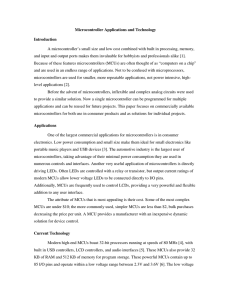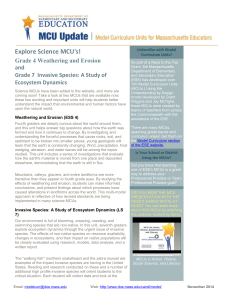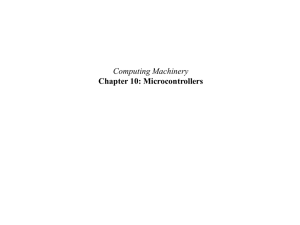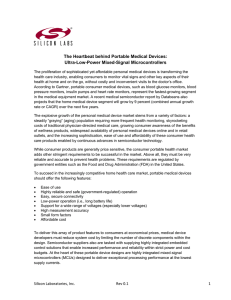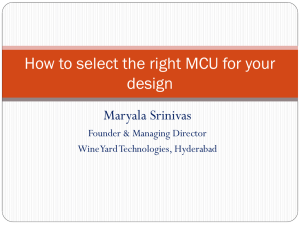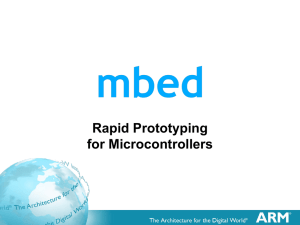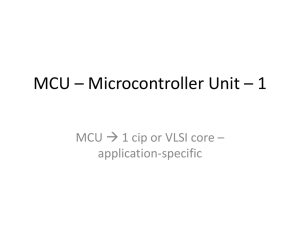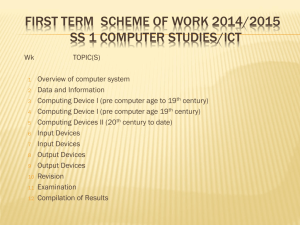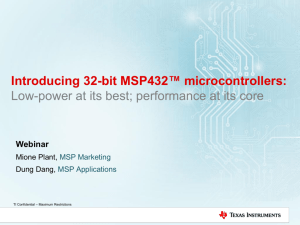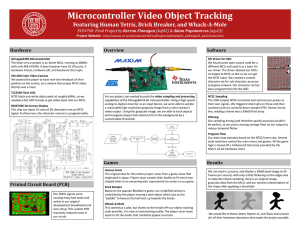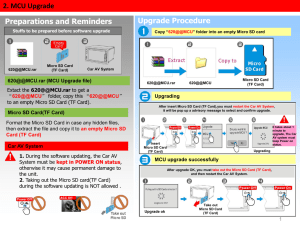Session Title
advertisement
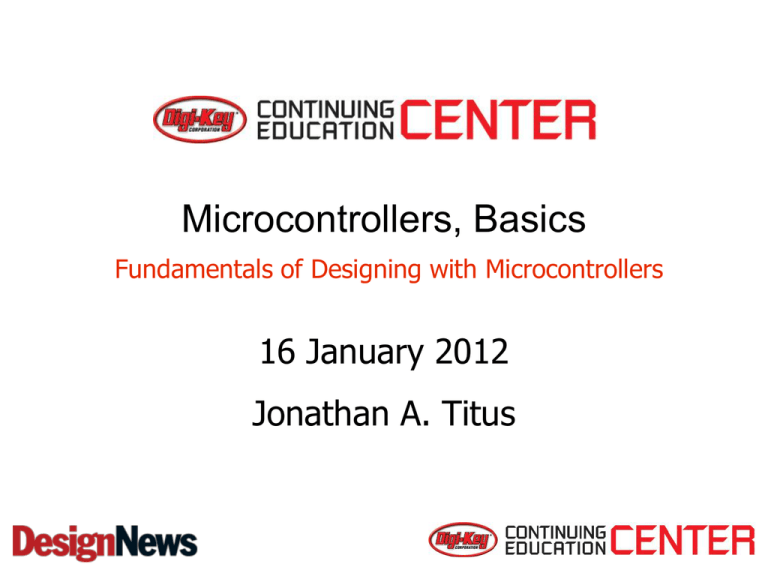
Microcontrollers, Basics Fundamentals of Designing with Microcontrollers 16 January 2012 Jonathan A. Titus Differences between Microprocessors and Microcontrollers • Microprocessors (μPs) • General-purpose compute “engine” • External memory and I/O devices • Often requires an operating system (OS) 2 Differences between Microprocessors and Microcontrollers • Microcontrollers (MCUs) • Usually chosen for a specific purpose • Small packages • On-chip memory and peripherals • Fast “on time,” no BIOS or OS needed 3 Where Did the MCU Come From? • Intel introduced the 8051 MCU in 1980 • Small amount of read-only memory (ROM) • External memory expansion if needed • Four 8-bit I/O ports • Not much different from today’s MCUs 4 8051 Architecture (1980) 5 Texas Instruments MSP430 MCU 6 Why Use an MCU? • • • • • • • Everything in one small package Mix and match peripherals and I/O types Lots of memory, flash for code, SRAM for data Readily available hardware and software tools Helpful support communities and forums Reference designs Code libraries and examples 7 What Peripherals Do MCUs Offer? • Digital I/O -- On or Off • Parallel signals • Pulse-width-modulated logic signals • Counters and timers • Analog I/O -- Voltages • Comparators • Analog-to-digital converters (ADCs) • Digital-to-analog converters (DACs) 8 What Peripherals Do MCUs Offer? • Communication Devices • UART or USART • SPI • I2C • I2S • CAN • USB • Ethernet • Interrupts 9 Peripherals Devices in MCUs • Parallel I/O Ports • Usually 8 or 16 bits for simultaneous control • Toggle individual bits • Require setup of registers 10 • Parallel I/O-Port Examples 11 How Do I Set Up I/O Ports? 12 Pulse-Width Modulator • PWM Peripheral • Converts a value to a proportional pulse width • Operate continuously and independently • Motor, LED, servo, and power control 13 Counters and Timers • Operate for a specific period or create a delay • Count external events, count up or down • Count clock “ticks” between the same or different events • Choose from various clock sources 14 Analog Comparator • Compare two voltages and... • Cause a bit to change state • Generate an interrupt • Wake an MCU from a sleep state 15 Analog-to-Digital Converter • Convert a voltage to a digital value; 8, 10, 12 bits... • Unipolar, 0 volts to MCU V+ (+3.3 or 5 volts) • Might require external signal conditioning 16 Digital-to-Analog Converter • Unipolar output, might require external offset • High-impedance output, could require buffering • 10- and 12-bit DACs common on MCUs • Filter a PWM output to get an analog voltage 17 UART Communications • Universal Asynchronous Receiver-Transmitter (UART) • Serial communications • Self-timing operations • Usually 8-bit transmissions at standard rates • Common on most MCUs 18 UART Communications Timing Communications at 9600 bits/sec 19 Serial-Communications • Reference • “Serial Port Complete,” 2nd ed., by Jan Axelson, Lakeview Research, 2007. ISBN: 978-1931448-06-2. 20 Serial Peripheral Interface (SPI) • Used for chip-to-chip communications • Requires a clock signal to all SPI (“spy”) devices • Not a formal standard • Operates with ADCs, DACs, real-time clocks 21 Inter Integrated-Circuit Interface (I2C) • Similar to SPI communications, but two wires • Multiple masters and slaves • Acknowledgements and bus arbitration • Philips (NXP) standard (Rev. 3, June 2007) 22 23 Controller-Area Network (CAN) • A standard for vehicle equipment • Uses an ISO-type “stack” • 2-wire differential bus, no common ground needed • Uses standardized packets of information 23 Controller-Area Network (CAN) • References • ISO Standard 11898-x ($) • “Controller Area Network,” by Konrad Etschberger,” IXXAT Automation, 2001. ISB: 978-3-00007376-0. • “A Comprehensive Guide to Controller Area Network,” by Wilfried Voss, Copper Hill Media, 2008. ISBN: 978-0976511601. 24 25 Ethernet and USB • Governed by standards • Require a software “stack” • Purchase, license, or create one yourself • MCU vendors might have stacks • Some MCUs include everything except the physical interface (PHY) • Can demand considerable memory • Start with a development kit or reference design 25 26 Interrupts • Cause immediate action • Internal and external hardware and software sources • Two types of action -- one or many vectors • Can present debug challenges 26 An ADC Interrupt 27 How Do I Get a Quick Start? 28 How Do I Get Started? 29 Hed • Text • Bullets • If • Needed 30
